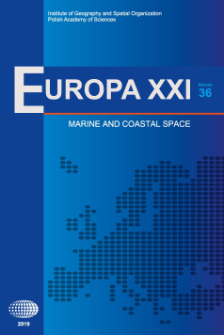
Obiekt
Tytuł: Container port expansion towards the sea in the context of maritime spatial planning
Inny tytuł:
Wydawca:
Miejsce wydania:
Opis:
Każdy numer posiada własny tytuł.
Typ obiektu:
Abstrakt:
The growth in the size of ships causes, in particular, a significant increase in demand for port surfaces and for the depths of water areas needed to serve ships in the ports. Due to technological changes in the transshipment and storage systems, and, on the other hand, due to the continuing pressure of developing cities, ports have increasingly rarely the adequate space reserves for their activities, and so currently they move towards the sea with their activities. The paper discusses the reasons for the phenomenon of expansion of ports towards the sea and its effects on maritime spatial planning.
Bibliografia:
Bird, J. (1971). Seaports and Seaport Terminals. London: Hutchinson and Company.
Daduna, J.R. (2011). Importance of Hinterland Transport Networks for Operational Efficiency in Seaport Container Terminals. In J.W., Böse (Ed.). Handbook of Terminal Planning (pp. 381-397). New York: Springer-Verlag.
EC (2014). Directive 2014/89/EU of the European Parliament and of the Council of 23 July 2014 establishing a framework for maritime spatial planning.
Hayuth, Y. (1981). Containerisation and the load center concept. Economic Geography, 57(2), 160-176. https://doi.org/10.2307/144140
Krośnicka, K.A. (2010). The Impact of Sea-River Ports on Spatial Development of Cities. Logistics and Transport, 2(11), 39-44.
Krośnicka, K.A. (2014). Where does the container terminal really end? In A., Brandeis (Ed.). Water and Cities. Managing a Vital Relationship (pp. 1272-1279). Proceedings of the 50th ISOCARP Congress Gdynia Urban Transformations: Cities and Water, Poland, 23-26 September 2014.
Krośnicka, K.A. (2016). Przestrzenne aspekty kształtowania i rozwoju morskich terminali kontenerowych. Gdańsk: Wydawnictwo Politechniki Gdańskiej.
Krośnicka, K.A. (2018). Spatial Evolution of the European Container Ports' System in Perspective of the Location Theory. SHS Web of Conferences, 58, 01016, pp. 12. https://www.shs-conferences.org/articles/shsconf/abs/2018/19/shsconf_globmar2018_01016/shsconf_globmar2018_01016.html https://doi.org/10.1051/shsconf/20185801016
Lu, J., & Chang, Z. (2013). The Construction of Seamless Supply Chain Networks: The Development of dry Ports in China. In R., Bergqvist, G., Wilmsmeier & K. Cullinane (Eds.). Dry Ports - A Global Perspective: Challenges and Developments in Serving Hinterlands (pp. 155-172). Farnham, Surrey, Burlington: Ashgate.
Monios, J., & Wilmsmeier, G. (2012). Giving a direction to port regionalization. Transportation Research Part A, 46(10), 1551-1561. https://doi.org/10.1016/j.tra.2012.07.008
Monios, J., & Wilmsmeier, G. (2013). The role of intermodal transport in port regionalization. Transport Policy, 30, 161-172. https://doi.org/10.1016/j.tranpol.2013.09.010
Rodrigue, J.-P., & Notteboom, T. (2010). Foreland based regionalization: Integrating intermediate hubs with port hinterlands. Research in Transport Economics, 27(1), 19-29. https://doi.org/10.1016/j.retrec.2009.12.004
Schätzl, L. (1996). Wirtschaftsgeographie 1 - Theorie (6th Edition). Paderborn: UTB.
Slack, B. (2007). The terminalisation of seaports. In J., Wang, D., Olivier, T., Notteboom & B., Slack (Eds.). Port, Cities and Global Supply Chains (pp. 41-50). Hampshire: Ashgate Publishing Limited.
Wang, C., & Ducruet, C. (2012). New port development and global city making: emergence of the Shanghai-Yangshan multilayered gateway hub. Journal of Transport Geography, 25, 58-69. https://doi.org/10.1016/j.jtrangeo.2012.07.008
Wiegmans, B., Masurel, E., & Nijkamp, P. (1999). Intermodal Freight Terminals: an Analysis of the Terminal Market. Transportation Planning and Technology, 23, 105-128. https://doi.org/10.1080/03081069908717643
Zaucha, J., & Matczak, M. (2018). Role of Maritime Ports and Shipping in the Creation of the Economic Value of the Sea Areas. SHS Web of Conferences, 58, 01033, pp. 9. https://doi.org/10.1051/shsconf/20185801033
Czasopismo/Seria/cykl:
Tom:
Strona pocz.:
Strona końc.:
Szczegółowy typ zasobu:
Format:
Rozmiar pliku 0,7 MB ; application/octet-stream
Identyfikator zasobu:
oai:rcin.org.pl:108071 ; 1429-7132 (print) ; 10.7163/Eu21.2019.36.9
Źródło:
CBGiOŚ. IGiPZ PAN, sygn.: Cz.6406, Cz.6407 ; kliknij tutaj, żeby przejść
Język:
Język streszczenia:
Prawa:
Licencja Creative Commons Uznanie autorstwa 4.0
Zasady wykorzystania:
Zasób chroniony prawem autorskim. [CC BY 4.0 Międzynarodowe] Korzystanie dozwolone zgodnie z licencją Creative Commons Uznanie autorstwa 4.0, której pełne postanowienia dostępne są pod adresem: ; -
Digitalizacja:
Instytut Geografii i Przestrzennego Zagospodarowania Polskiej Akademii Nauk
Lokalizacja oryginału:
Dofinansowane ze środków:
Dostęp:
Kolekcje, do których przypisany jest obiekt:
- Instytut Geografii i Przestrzennego Zagospodarowania PAN > Publikacje pracowników i Wydawnictw
- Instytut Geografii i Przestrzennego Zagospodarowania PAN > Biblioteka Instytutu > Serie/Czasopisma/Cykle
Data ostatniej modyfikacji:
13 paź 2023
Data dodania obiektu:
23 sty 2020
Liczba pobrań / odtworzeń:
835
Wszystkie dostępne wersje tego obiektu:
https://www.rcin.org.pl/igipz/publication/134525
Wyświetl opis w formacie RDF:
Wyświetl opis w formacie RDFa:
Wyświetl opis w formacie OAI-PMH:
| Nazwa wydania | Data |
|---|---|
| Krośnicka K. : Container port expansion towards the sea in the context of maritime spatial planning | 13 paź 2023 |
Obiekty Podobne
Jerzak, Katarzyna Shrayer, Maxim D Krośnicka, Karolina A Lorens, Piotr Zaucha, Jacek Pardus, Joanna
Neimane, Leila Pužulis, Atmands
Habenicht, Hermann (1844–1917) Knipping, Erwin
Laskowicz, Tomasz

 INSTYTUT ARCHEOLOGII I ETNOLOGII POLSKIEJ AKADEMII NAUK
INSTYTUT ARCHEOLOGII I ETNOLOGII POLSKIEJ AKADEMII NAUK
 INSTYTUT BADAŃ LITERACKICH POLSKIEJ AKADEMII NAUK
INSTYTUT BADAŃ LITERACKICH POLSKIEJ AKADEMII NAUK
 INSTYTUT BADAWCZY LEŚNICTWA
INSTYTUT BADAWCZY LEŚNICTWA
 INSTYTUT BIOLOGII DOŚWIADCZALNEJ IM. MARCELEGO NENCKIEGO POLSKIEJ AKADEMII NAUK
INSTYTUT BIOLOGII DOŚWIADCZALNEJ IM. MARCELEGO NENCKIEGO POLSKIEJ AKADEMII NAUK
 INSTYTUT BIOLOGII SSAKÓW POLSKIEJ AKADEMII NAUK
INSTYTUT BIOLOGII SSAKÓW POLSKIEJ AKADEMII NAUK
 INSTYTUT CHEMII FIZYCZNEJ PAN
INSTYTUT CHEMII FIZYCZNEJ PAN
 INSTYTUT CHEMII ORGANICZNEJ PAN
INSTYTUT CHEMII ORGANICZNEJ PAN
 INSTYTUT FILOZOFII I SOCJOLOGII PAN
INSTYTUT FILOZOFII I SOCJOLOGII PAN
 INSTYTUT GEOGRAFII I PRZESTRZENNEGO ZAGOSPODAROWANIA PAN
INSTYTUT GEOGRAFII I PRZESTRZENNEGO ZAGOSPODAROWANIA PAN
 INSTYTUT HISTORII im. TADEUSZA MANTEUFFLA POLSKIEJ AKADEMII NAUK
INSTYTUT HISTORII im. TADEUSZA MANTEUFFLA POLSKIEJ AKADEMII NAUK
 INSTYTUT JĘZYKA POLSKIEGO POLSKIEJ AKADEMII NAUK
INSTYTUT JĘZYKA POLSKIEGO POLSKIEJ AKADEMII NAUK
 INSTYTUT MATEMATYCZNY PAN
INSTYTUT MATEMATYCZNY PAN
 INSTYTUT MEDYCYNY DOŚWIADCZALNEJ I KLINICZNEJ IM.MIROSŁAWA MOSSAKOWSKIEGO POLSKIEJ AKADEMII NAUK
INSTYTUT MEDYCYNY DOŚWIADCZALNEJ I KLINICZNEJ IM.MIROSŁAWA MOSSAKOWSKIEGO POLSKIEJ AKADEMII NAUK
 INSTYTUT PODSTAWOWYCH PROBLEMÓW TECHNIKI PAN
INSTYTUT PODSTAWOWYCH PROBLEMÓW TECHNIKI PAN
 INSTYTUT SLAWISTYKI PAN
INSTYTUT SLAWISTYKI PAN
 SIEĆ BADAWCZA ŁUKASIEWICZ - INSTYTUT TECHNOLOGII MATERIAŁÓW ELEKTRONICZNYCH
SIEĆ BADAWCZA ŁUKASIEWICZ - INSTYTUT TECHNOLOGII MATERIAŁÓW ELEKTRONICZNYCH
 MUZEUM I INSTYTUT ZOOLOGII POLSKIEJ AKADEMII NAUK
MUZEUM I INSTYTUT ZOOLOGII POLSKIEJ AKADEMII NAUK
 INSTYTUT BADAŃ SYSTEMOWYCH PAN
INSTYTUT BADAŃ SYSTEMOWYCH PAN
 INSTYTUT BOTANIKI IM. WŁADYSŁAWA SZAFERA POLSKIEJ AKADEMII NAUK
INSTYTUT BOTANIKI IM. WŁADYSŁAWA SZAFERA POLSKIEJ AKADEMII NAUK
































